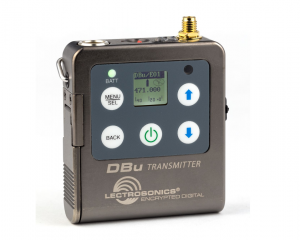Tech Focus: Wireless Bodypacks, Part 1 — Smaller, Tougher, Smarter
After RF repack, wider tuning ranges and encryption are major considerations
Story Highlights
Wireless bodypacks have been getting smaller and tougher in recent years, in response to broadcast sports’ increased use of wireless sound from the field and on athletes. With mics routinely buried in the dirt around home plate and the pitcher’s mound or attached to NFL linemen, who repeatedly bring thousands of PSI to bear on scrimmage lines, these transmitters have had to shrink in size even as they have had to increase in functionality and endurance — and do so without hurting the players they’re monitoring in the case of a fall.
Now broadcast sports is asking those same miniature marvels to get even smarter, too.
Demand for Encryption Grows
Wireless bodypacks are expected to be able to be remotely controlled, to manage their own power supplies while navigating a radically transformed RF-spectrum landscape, and, when necessary, to also operate in spy mode.
According to Lectrosonics VP, Sales and Marketing, Karl Winkler, although the usual requirements around miniaturization, comfort, and robustness still apply, the main changes of the past year revolve around RF-spectrum loss.
“With less spectrum available now,” he points out, “we need to provide wider tuning ranges. A few years ago, our transmitters would have had 256 channels across 25 MHz of bandwidth; now we’re up to 6,000 channels to choose from over 144 MHz. The tuning-step sizes are packed much tighter, which provides more choices for frequency-coordination planning and lets users cover more area. That’s necessary especially in dense metro areas with a lot of adjacent TV channels after the repack.”
Winkler also reports an increase in requests for encryption capability in wireless audio systems for sports, including, for instance, on the wireless systems that Lectrosonics supplies for coaches’ calls on ESPN’s NBA broadcasts. That kind of audio can be guarded by using delays and airing it only on replays, but, says Winkler, leagues and teams are increasingly concerned about the potential for its being intercepted by those wirelessly scanning for it, for either amusement or nefarious purposes, using anything from sophisticated scanners to iPhones with specialized apps.
“It’s a reflection of a much greater awareness around security in general,” he says, noting that RF-systems vendors and systems integrators working on sports venues are also generating demand for more encrypted wireless systems. “There’s just greater sensitivity around the security of all kinds of data now, and that certainly extends to wireless audio for sports.”
Michael Johns, senior product manager, wireless systems, Shure, says bodypacks are shrinking in size and their materials are being scrutinized more closely, with increased awareness around the kind of heat that more powerful, longer-lasting batteries can generate.
That’s an issue for a product that’s worn close to the skin, he explains. “As a result, we’re moving away from metals that conduct heat and towards more esoteric, less thermally efficient materials.”
The ‘Other’ IP
Another consideration that’s increasingly important with bodypacks showing up more often on the field of play, attached to athletes and officials, is resistance to moisture and particulates. The Ingress Protection (IP) rating is a two-digit metric that defines levels of electrical enclosures’ sealing effectiveness against intrusion by foreign bodies (tools, dirt, etc.) and various kinds of moisture. It’s a widely used industrial measurement, though not as widely disclosed; it’s best used, he says, as an advisory reference.
“It’s a very useful measurement, but the problem is, it can be seen as an absolute [value],” says Johns. “A rating of seven” — a reference to the second digit, valuing moisture resistance — “might indicate that a unit can still work 2 meters under water for 30 minutes, but that’s not how it’s actually going to be used. You want to know how it’s going to perform on the sidelines on a rainy day. We do IP measurements — we’re certified as a company to do so — but we use them as references for the bodypacks’ environmental performance in the real world.”
Barring another revolution in nano-battery technology, wireless bodypacks have likely reached their limit in terms of physical size. In terms of performance and features, however, it’s reasonable to expect next year’s look at the topic to have a new wrinkle or three.
Click here for Tech Focus: Wireless Bodypacks, Part 2 — A Look at the Leading Transmitters

